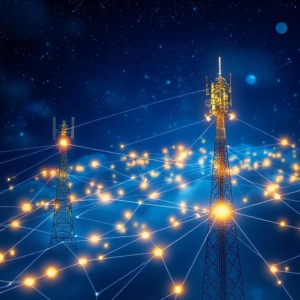A cellular network is a system used by mobile phones and other wireless devices to communicate with each other. Instead of one big tower covering an entire area, the network is divided into smaller cells, each covered by its own cell tower. These towers work together to allow mobile phones to make calls, send messages, and access the internet wherever you go. Cellular networks are the invisible systems that connect your phone to the rest of the world. They have evolved from simple 2G systems that only allowed calls and texts to the super-fast 5G networks. Understanding how cellular networks work helps explain why we can stay connected, no matter where we are.

How Do Cellular Networks Work?
Imagine you are walking through a city with your mobile phone. As you move from one area to another, your phone constantly connects to the nearest cell tower (like a mini antenna) that covers that area. These cell towers are connected to each other and to a central system that manages all the communication. When you move from one cell to another, the network hands off your connection from one tower to another, so you don’t lose the signal.
Types of Cellular Networks
There are different generations of cellular networks, each offering better technology, faster speeds, and more features. Here’s a simple explanation of each:
2G (Second Generation):
2G introduced digital signals for mobile communication. Before 2G, phones used analog signals, which were less reliable.
Key features: Voice calls and basic text messaging (SMS).
Speed: Slow data speeds, only suitable for basic tasks like calling and texting.
3G (Third Generation):
3G brought faster data speeds and made it possible to browse the internet, use apps, and make video calls.
Key features: Web browsing, email, video calling, and better internet access.
Speed: Much faster than 2G, but still not as fast as current networks.
4G (Fourth Generation):
4G significantly improved internet speed and allowed for smooth video streaming, fast downloads, and mobile gaming.
Key features: High-speed internet for video streaming (like Netflix), gaming, and HD video calls.
Speed: Very fast, much faster than 3G, allowing high-definition videos and apps to work smoothly.
5G (Fifth Generation):
5G is the latest and fastest technology for mobile networks. It is designed to handle a huge number of devices and provide ultra-fast speeds.
Key features: Extremely fast internet, low latency (very little delay), and the ability to connect many more devices at once.
Speed: Extremely fast, enabling things like self-driving cars, smart cities, and advanced technology like virtual reality (VR).
Key Components of Cellular Networks
Cell Towers (Base Stations):
These are the antennas that send and receive signals for mobile devices. Each tower covers a small area called a cell.
Cells:
A cell is a small area served by one tower. As you move around, your phone switches between cells to keep the connection strong.
Mobile Devices:
Devices like smartphones, tablets, and other wireless gadgets that connect to the network to make calls or use the internet.
Core Network:
The core network is the brain of the cellular system. It routes calls, messages, and internet traffic, making sure it reaches the right device.
Cellular Network Analysis
Cellular network analysis is the process of studying how well the network is performing. This helps ensure good coverage, fast speeds, and reliable service. Here’s how it’s analyzed:
Coverage:
It’s important to know how much of an area is covered by the network. Good coverage means your phone can stay connected to a nearby tower without dropping calls or losing the signal.
Capacity:
This refers to how many people or devices can use the network at the same time without causing a slowdown. Networks need to handle a lot of users, especially in crowded areas.
Speed:
Speed tests measure how fast data can be uploaded or downloaded. Faster speeds mean better internet experiences for activities like video streaming or gaming.
Signal Strength:
Signal strength shows how strong the connection is between your phone and the cell tower. A stronger signal means better quality calls and faster internet.
How Cellular Networks are Organized
Frequency Bands:
Cellular networks operate on different frequency bands. These are like lanes on a highway. Each lane allows data to travel at different speeds. As technology improves (like moving from 3G to 4G), new frequency bands are used to provide more space for data.
Handover Process:
When you move around, your phone might need to connect to a different cell tower. This process is called handover. It’s like passing the baton in a relay race, ensuring that your phone stays connected to the network as you move.
Why are Cellular Networks Important?
Cellular networks have an impact on our daily lives, as they allow us to:
- Access the internet anywhere, anytime, for work, learning, or entertainment.
- Use mobile apps for tasks like navigation, shopping, banking, and much more.
Tags: 2G, 3G, 4G, 5G, analog signals, base stations, capacity, cell towers, cells, cellular network, cellular network analysis, Cellular Networks, connected devices, core network, coverage, data routing, Data transfer, digital signals, frequency bands, gaming over mobile, generations of cellular networks, handover process, high-speed data, internet access, internet access on-the-go, low latency, mobile apps, mobile broadband, mobile communication, mobile connectivity, Mobile devices, mobile internet, mobile network evolution, mobile phones, mobile signal., mobile technology, network architecture, network performance, network reliability, self-driving cars, signal strength, Smart Cities, smartphone network, SMS, speed test, streaming services., Telecommunications, video calling, virtual reality, voice calls, web browsing, wireless communication, wireless devices, wireless infrastructure


